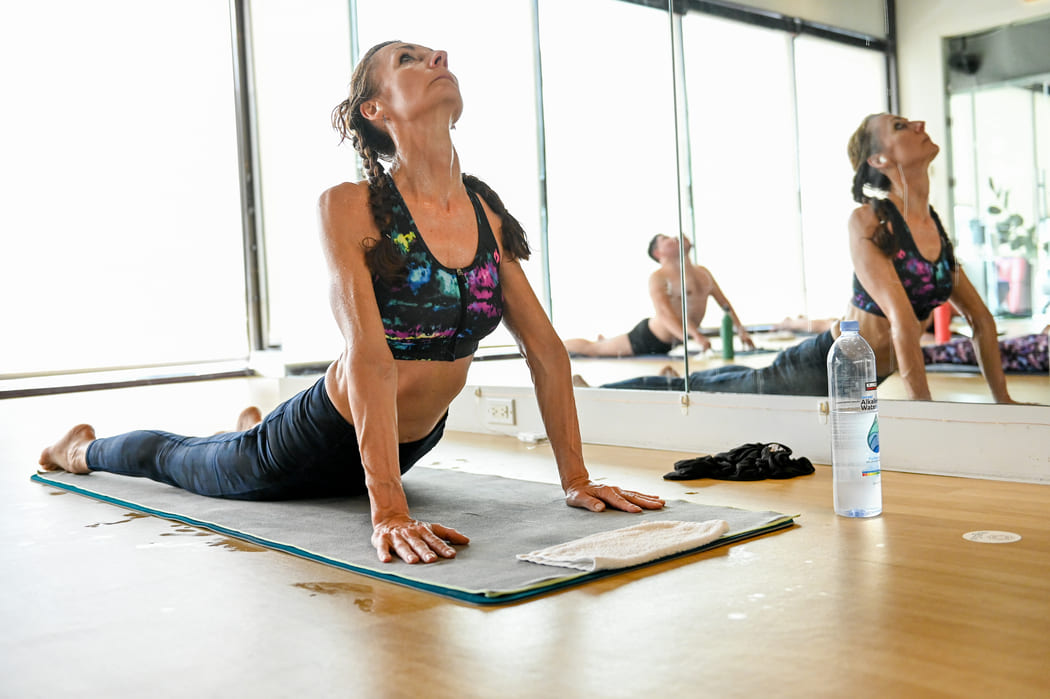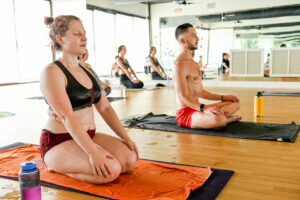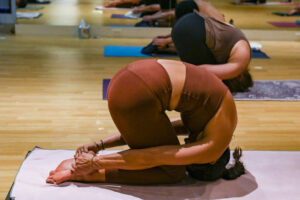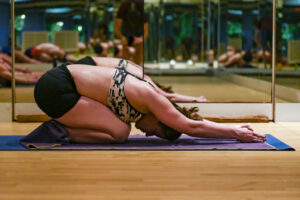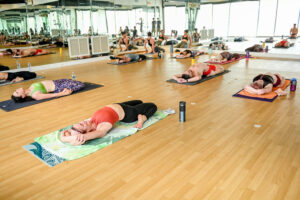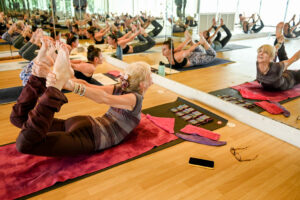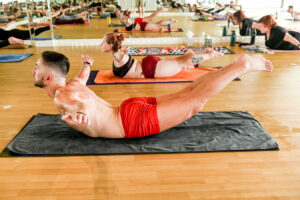Arguably, one of the most challenging yet rewarding Bikram Yoga poses is the Ustrasana (camel pose). Demanding a handful of spinal dexterity, this particular pose, once mastered, can open the door to a dreamscape of peace and calm.
A vital aspect of mastering this pose lies in recognizing and embracing these powerful emotions. It’s about finding comfort in your posture and being open to the idea that these natural feelings can be acknowledged and allowed to naturally pass through your being.
By doing so, you not only conquer half the battle but also access the advantages this pose has to offer your body, mind, and spirit!
Before diving into the Camel Pose, here is what we will cover in this article:
The Backstory of the Ustrasana (Camel Pose)
The roots of the Ustrasana, the 22nd pose in the Bikram Yoga cycle, can be traced back to the ancient scriptures of India, particularly the “Hatha Yoga Pradipika” and the “Yoga Korunta.” These texts are considered pillar pieces—definitive sources for understanding the history and philosophy of yoga, and are the foundations on which the Bikram Yoga cycle is based.
The Ustrasana, commonly known as the camel pose, has deep roots in the ancient traditions of yoga. Originally, this pose was considered a foundational step in preparing the body for the more advanced and intricate postures that yogis face in their journey (not to mention it prepares you well for the next pose in the cycle, the rabbit pose).
It served as a gateway, gradually coaxing the body into greater flexibility and strength. Additionally, the Ustrasana was seen as a powerful tool to instill a sense of inner peace and tranquility, allowing practitioners to shed the burdens of everyday stress and tension that tend to accumulate within the body.
The physical execution of the Ustrasana is striking, as the body arches backward, mimicking the curve of a camel’s hump. However, its significance goes well beyond the realm of physical posturing. It symbolizes a profound concept deeply rooted in yoga philosophy—the act of opening the heart. This opening is not limited to the physical realm but extends to the spiritual and emotional dimensions as well.
To get a little more poetic, the act of arching your body backward in the camel pose is just like opening the petals of a heart flower. It’s an invitation to embrace vulnerability, to let go of emotional walls, and to connect with one’s innermost self.
This heart-opening gesture, both physical and symbolic, can be transformative, bringing a sense of liberation and emotional release.
Moreover, the camel pose is intended to help yogis confront their fears and anxieties, just as a camel faces the challenges of the arid desert with resilience and determination. To that end, this pose teaches us to confront our fears head-on, to acknowledge them, and ultimately, to rise above them.
It’s a reminder that the path to personal growth and spiritual development often requires us to navigate through uncomfortable and challenging territory—just as a camel in the desert!
How to Perform the Camel Pose (Step-by-Step)
Although, at first glance, it may strike you as a physically demanding pose, it’s actually not as complex as you might think. Each pose of the Bikram Yoga sequence is meant to lead into the next, and your body is meant to be prepared for each pose when exiting the prior pose. In this way, your body and mind will be prepared to transition into even the seemingly more robust poses, including the camel pose.
Let’s walk through the steps now:
- Begin in a Kneeling Position: Commence with your knees positioned hip-width apart and the tops of your feet gently resting on the mat.
- Hips Forward: Inhale deeply, directing your hips forward to align them with your knees.
- Lengthen the Spine: As you continue to breathe, extend your spine by drawing your tailbone downward, finding a natural sense of balance and alignment.
- Arch Back Slowly: Reach back with your hands, one at a time, extending them gracefully toward your heels.
- Open the Heart: As you exhale, gently push your pelvis forward, lifting your chest upward.
- Engage Your Core: To safeguard your lower back and spine, engage your core muscles, providing stability and support.
- Look Back: If it feels comfortable, let your head drop backward, gazing at the wall behind you, as you savor the openness this pose brings.
- Hold and Breathe: And you’re there! Take this moment to embrace the pose for several breaths, savoring the sensation, and then, ever so gently, release.
Benefits of the Camel Pose
The Ustrasana, or the camel pose, bestows a treasure trove of benefits, making it an indispensable part of the Bikram yoga practice. Here’s a closer look at the myriad advantages this asana offers:
Backbend Bliss
The camel pose is probably the best motion you’ll make in bending your back, effectively counteracting the long hours we spend hunched over desks and screens. It provides a deep stretch to the front of the body, encouraging improved posture and spinal health.
Emotional Release
The heart-opening nature of this pose can serve as an emotional release valve. The stretch across the chest and heart area can facilitate the release of pent-up emotions, allowing practitioners to experience a sense of emotional freedom and lightness.
Core Strengthening
Performing the camel pose is not just about testing the limits of your flexibility; it’s more about strengthening your core. As you arch your back and lift your chest, the core muscles come into play, providing a gentle yet effective workout.
Enhanced Lung Capacity
The deep, expansive breaths taken during the Ustrasana can contribute to increased lung capacity and better oxygen intake. This makes it a valuable pose for anyone looking to improve their respiratory health.
Improved Digestion
The compression of the abdominal region in this pose can stimulate digestion and alleviate common issues like constipation. It helps to massage the internal organs and keep them functioning optimally.
Modifications for the Camel Pose
While the camel pose can be incredibly rewarding, it’s essential to approach it with awareness and make necessary modifications as needed. Here are a couple of options to consider.
If reaching for your heels feels challenging, place yoga blocks or a bolster beside your feet. This provides additional support and lessens the intensity of the backbend, allowing you to gradually progress into the full expression of the pose.
If balance and stability are concerns, especially for beginners, practicing the Ustrasana near a wall can provide added support and security. It allows you to focus on the backbend without worrying about balance.
Last Thoughts on the Ustrasana (Camel Pose)
The camel pose embodies the spirit of Bikram yoga, a practice that thrives in the heat and encourages the body to bend and stretch, unveiling new dimensions of potential. Whether you’re a seasoned Bikram enthusiast or simply curious about deepening your yoga journey, the rewards of this pose are profound and not to be overlooked.
So, the next time you step onto your yoga mat within the warm cocoon of a Bikram Yoga studio, remember the grace and strength of the camel pose. With each time that you gracefully arch your back, let it serve as a reminder of the boundless potential that resides within you, both physically and emotionally. The Ustrasana is not just another yoga pose (as is the case with any of the other poses in the Bikram Yoga cycle!); it’s yet another invitation to rediscover your body and soul in a new and different way.
FAQ
Q: Will I be flexible enough to do the Camel Pose?
A: It’s a valid concern, especially if you’re new to yoga. The Camel Pose demands a certain degree of flexibility, particularly in the spine, shoulders, and thighs. However, the beauty of yoga is that it’s a journey, not a destination. With regular practice and gentle, consistent stretching, you can gradually increase your flexibility and work your way towards mastering the Camel Pose.
Q: I’m worried about straining my back.
A: The Camel Pose involves a backward bend, and if not done correctly, it can indeed strain your back. To mitigate this concern, it’s crucial to approach the pose gradually and with proper guidance. Start with smaller backbends and warm-up exercises to prepare your spine and back muscles. Yoga instructors emphasize alignment and awareness during the pose, ensuring your back remains safe. It’s part of why we encourage guided classes for new yogis trying these positions for the first time!
Q: Will it be painful or uncomfortable?
A: You might experience some discomfort initially, especially if you’re not accustomed to the stretch. However, yoga encourages mindful practice and listening to your body. Pain is a sign to stop or adjust. As you gradually build flexibility and strength, any discomfort should decrease. Proper warm-ups, guidance, and using props when needed can also help free you of any discomfort. The goal here is to feel tension, but not pain.
 -ing our NEW! Community Classes!
-ing our NEW! Community Classes!
